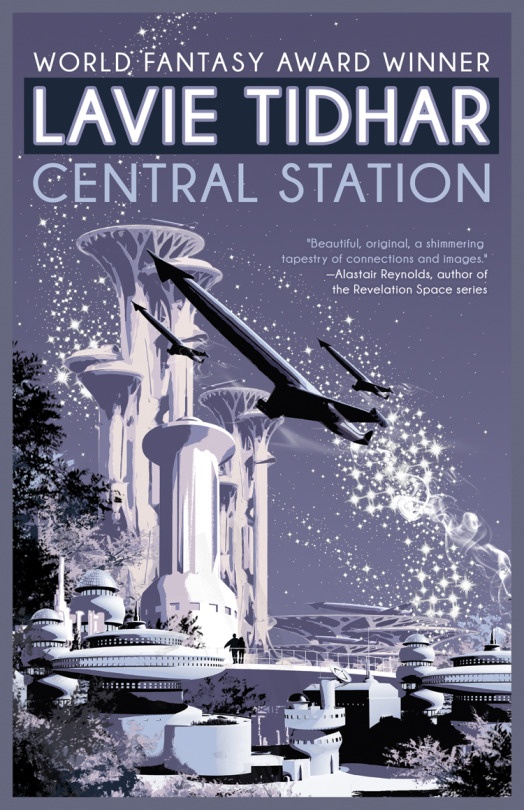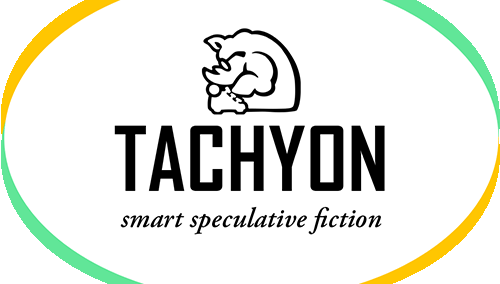CENTRAL STATION is one of the highlights of the year
A trio of reviews for Lavie Tidhar’s moving, lyrical, and insightful CENTRAL STATION.

THIERSTEIN.NET praises the novel.
The entire environment is brought beautifully to life for the reader – not with long descriptions, but with evocative moments and little key points thrown in. It positively brims with ideas and concepts, painting with sights and smells a believable, tangible future world which you can taste and feel, and containing a sparkling cast of characters, each with their own life and drives.
The structure of the book is a series of short stories, which on the one hand can stand on their own (all but 2 were previously published individually), but which loosely connect on tangents and topics, intertwine, and trace a picture of something bigger. No, I’m not going to tell you what it is, but overall this is the story of a beginning, or a change.
Overall the set-up greatly reminded me of Ian McDonald’s CYBERABAD DAYS, whilst CENTRAL STATION itself is more than a little reminiscent of Somtow Sucharitkul’s MALLWORLD – both are classics as touchstones, and I think he does a very good job living up to them!
The book is full of references to other, frequently ‘classic’ SF. As an example – there is a mention from a Robotnik about someone using Sand Worms as weapons in the Middle East; never mind the robot priest R. Brother Patch-It praying: “Our maker who art in the zero point field, hallowed be thy nine billion names…”
The individual stories and strands are told from numerous viewpoints, and follow a variety of protagonists – we see the movers, we see the reacting ones, and in-between those who live in the moment. The strands themselves are winding around each other, touching, parting. Like a tapestry, where no single strand tells the story, but together they draw a picture.
The book starts with a Prologue placing this – for us – future story into a different frame; we are being told and shown history, a key point in the development of humanity on its way to the stars, a documentary. And I felt that, in the end, it didn’t fully deliver on this, it stopped short and left me hanging with part of that story untold.
But this is a minor quibble, and might just be me… overall I think this is a great book, most likely one of the highlights of the year, and comes highly recommended for everyone who enjoys modern, intelligent Science Fiction in an unusual setting.

Wendy Bousfield at THE FUTURE FIRE really enjoyed the book.
Lavie Tidhar’s moving, lyrical, insightful work of speculative fiction, CENTRAL STATION, extrapolates a future in which humanity is entering a new evolutionary stage, triggered by growing immersion in the Internet. In Tidhar’s world, “nodes,” implanted at conception in “birthing clinics” (there are no natural births), provide direct access to the “Conversation”: “a hundred thousand… voices, channels, music, languages, the high-bandwidth indecipherable toktok of Others, weather reports, confessionals, off-world broadcasts time-lagged from Lunar Port and Tong Yun and the Belt…” (23). Akin to Arthur C. Clarke’s
CHILDHOOD’S
END, CENTRAL STATION traces the emergence of children psychically linked to one another and to other minds, both human and mechanical.
<snip>
Tidhar is not merely an astute social critic, but also a gifted stylist. Woven into the text are allusions to classic works of science fiction, especially those of Philip K. Dick and Cordwainer Smith: characters are “ubicked”; refuse is “kipple”; spacers travel into the “Up and Out”; “C’Mell” is worshipped as a saint. Tidhar’s writing is lyrical and startlingly metaphoric. Crippled by information overload (his father’s memories have been implanted in his brain), Vlad forgets his wife’s name: “Her name disappeared, the way keys or socks do. Misplaced and, later, could not be found” (242). Tidhar outdoes Anthony Burgess (
CLOCKWORK
ORANGE) in constructing not one, but TWO syntactically consistent future languages. The Robotniks speak Battle Yiddish, developed “like the Navajo of Code Talkers” for a “long-gone war” (114). Asteroid Pidgin is “the near-universal language of space.” Here is Hamlet’s famous soliloquy in Asteroid Pidgin: “Blong stap o no blong stap / Hemi wan gudfala kwesjen ia…” (106). The droll, allusive, poetic, polyglot language of CENTRAL STATION is one of its greatest joys.Though Tidhar is a prolific novelist and winner of the World Fantasy Award (OSAMA, 2012), many readers of mainstream fiction may well have never heard of him. Though CENTRAL STATION is in every way a literary masterpiece, it will not, alas, appear on the best seller lists. While the public embraces space operas like Star Wars and medieval fantasies like Game of Thrones, true speculative fiction remains a niche market. The ghettoizing of speculative fiction is unfortunate, since its mission is to bring to imaginative life the potential futures toward which we are blindly rushing.
For BOOKLIST, LynnDee Wathen reviews CENTRAL STATION.
Still, the novel is thought-provoking about the future of reality and our constant need for data. Fans of Tidhar and other thought-provoking science fiction may enjoy this highly intellectual novel.
For more info about CENTRAL STATION, visit the Tachyon page.
Cover by Sarah Anne Langton
